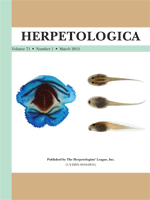Adult individuals of several anuran species exhibit conspicuous visual displays during intraspecific communication. While signal properties in adults have been subject to an increasing number of studies, little is known about the variation of visual signals in juveniles and during ontogenetic changes. Foot-flagging signals of the Bornean frogs Staurois guttatus and S. parvus were observed in juveniles a few days after metamorphosis. We investigated color parameters of foot webbings and body coloration of individuals bred at the Vienna Zoo, and their relation to age and body size using spectrophotometry. Our results indicate that the brightness of foot webbings of S. guttatus and S. parvus increased with increasing age. Additionally, we compared the results with measurements of adult individuals from a population in Brunei and discuss possible differences related to diet and age as well as the habitat use of juveniles and adults. We suggest that the ontogenetic increase in foot-webbing brightness enhances visual conspicuousness and the signal-to-noise ratio of the visual signal with sexual maturity and potentially functions as cue to the age of the signaler.
How to translate text using browser tools
1 March 2015
Ontogenetic Change of Signal Brightness in the Foot-Flagging Frog Species Staurois parvus and Staurois guttatus
Judith Stangel,
Doris Preininger,
Marc Sztatecsny,
Walter Hödl

Herpetologica
Vol. 71 • No. 1
March 2015
Vol. 71 • No. 1
March 2015
Body coloration
Color change
Color signal
Foot webbing
Ranidae
visual signals




